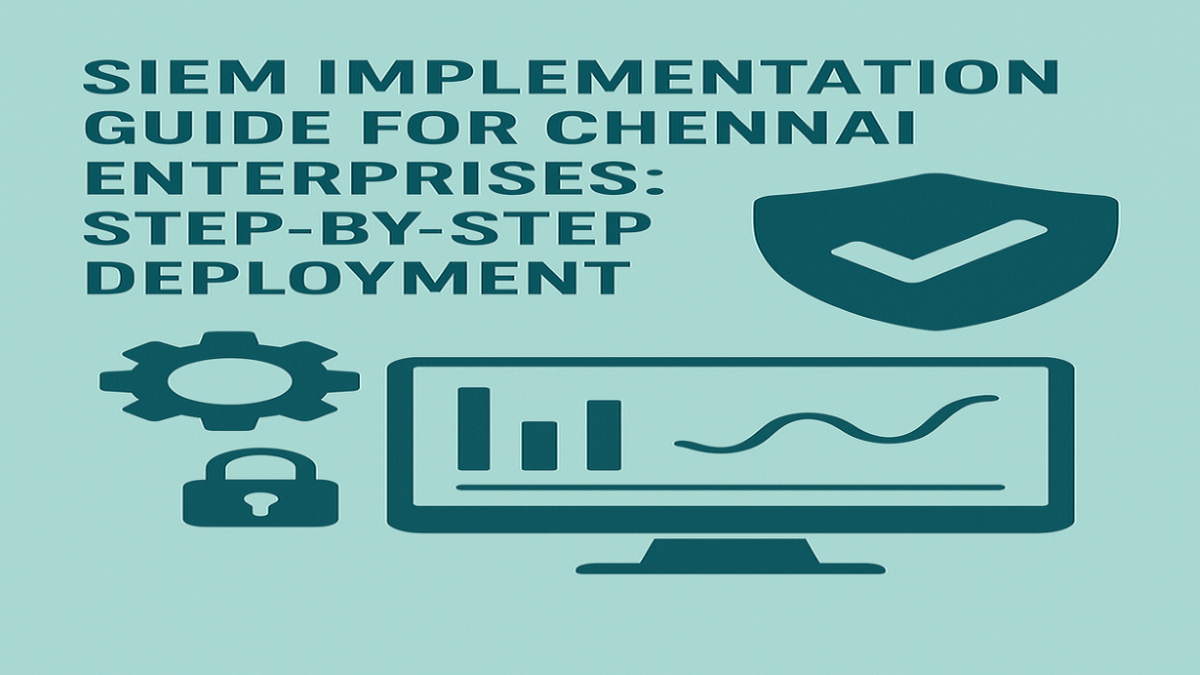SIEM Implementation Guide for Chennai Enterprises: Step-by-Step Deployment

Introduction
SIEM solutions enable enterprises to centralize event logging, real-time threat detection, compliance reporting, and incident response. In a region like Chennai, with its mix of global enterprises and local businesses, effective SIEM implementation improves cybersecurity and regulatory compliance.
Assess Needs and Define Objectives
- Begin by evaluating regulatory needs (GDPR, PCI-DSS, RBI, etc.), organization-specific security requirements, current controls, and existing infrastructure vulnerabilities.
- Clearly define the objectives: compliance monitoring, faster incident response, insider threat detection, or audit trail centralization.
- Identify all data sources: firewalls, endpoints, servers, cloud applications, databases, Active Directory, IDS/IPS, and business-critical applications.
Solution Selection & Planning
- Evaluate SIEM solutions for Chennai’s IT landscape (cloud-based, on-premises, or hybrid). Consider scalability, integration support, support for local compliance, ease of use, deployment models, and cost.
- Develop a rollout strategy: pilot in limited business units or critical systems, then expand as processes mature.
- Plan for integration with current tools and logging systems.
- Create a detailed implementation roadmap with stakeholder responsibilities and training requirements.
Architecture Design
- Map data flow: determine which sources provide which logs, how the logs are collected, and secure transmission/storage.
- Estimate bandwidth, storage, and compute resource needs for Chennai’s typical data volumes.
- Design for redundancy and failover to ensure high availability.
Deployment and Integration
- Carry out a phased deployment, starting with representative systems and then expanding to the entire environment.
- Install SIEM components/agents, configure log collection, and set up secure data flows from all key assets.
- Ensure integration with firewalls, antivirus, DLP, vulnerability management, DNS, proxy, and other business systems.
Configuration and Tuning
- Customize log parsing and normalization rules to handle local systems, custom applications, and unique Chennai business processes.
- Develop use cases specific to insider threats, external attacks, compliance violations, and sector-specific risks.
- Establish correlation rules, dashboards, and reports relevant for the enterprise’s needs.
Alerts, Response Workflows, and Runbooks
- Build alerting logic to distinguish critical incidents from noise.
- Document escalation paths, responsibilities, and automated response actions to streamline a Chennai-based SOC’s workflow.
- Test with real-world scenarios to ensure incident playbooks are practical and effective.
Team Training and Documentation
- Train Chennai-based analysts and IT teams on SIEM operations, incident handling, basic threat hunting, and reporting functionalities.
- Maintain comprehensive documentation: architecture diagrams, correlation rules, runbooks, and change logs.
Testing, Validation, and Optimization
- Simulate attacks, test alerting accuracy, review incident logging, and iterate on tuning rules to reduce false positives.
- Schedule regular reviews with leadership to demonstrate SIEM value and adjust for evolving regulatory or business needs.
Ongoing Maintenance and Continuous Improvement
- Regularly update correlation rules, integrate new data sources, review system performance, upgrade software, and monitor compliance posture.
- Use lessons from security incidents to refine configurations.
Conclusion
Implementing SIEM effectively is essential for Chennai enterprises to enhance their security posture, ensure regulatory compliance, and enable proactive threat detection and response. A successful SIEM deployment requires careful planning, including a deep understanding of organizational security needs, selecting the appropriate solution, designing a scalable architecture, and integrating with existing IT infrastructure. Ongoing tuning, regular training of security teams, and continuous optimization are critical to maximizing SIEM effectiveness, reducing false positives, and adapting to evolving threats. With these best practices, SIEM becomes a powerful tool that centralizes security monitoring, accelerates incident response, and ultimately strengthens the overall security resilience of the enterprise. This holistic approach ensures that SIEM is not just a technology investment, but a strategic asset for sustained cybersecurity success.
Take the Next Step with CodeSecure Solutions
Cyber threats are growing more sophisticated every day. With a trusted partner by your side, you can safeguard your business while focusing on what truly matters—growth and innovation.
At CodeSecure Solutions, we deliver comprehensive cybersecurity services in Chennai, uniquely tailored for startups, SMEs, and enterprises:
- Vulnerability Assessment & Penetration Testing (VAPT)
- Network Security Solutions
- Compliance Support (ISO 27001, PCI-DSS, HIPAA, DPDP Act, GDPR)
- Cloud & Endpoint Protection
- Security Awareness Training
No matter your industry or size, CodeSecure customizes solutions to fit your needs—ensuring your data, reputation, and operations remain secure.
Ready to Strengthen Your Defenses?
- 📞 Call: +91 73584 63582
- ✉️ Email: [email protected]
- 🌐 Visit: www.codesecure.in
Stay secure. Stay informed. Choose CodeSecure Solutions—your partner in cyber resilience.
